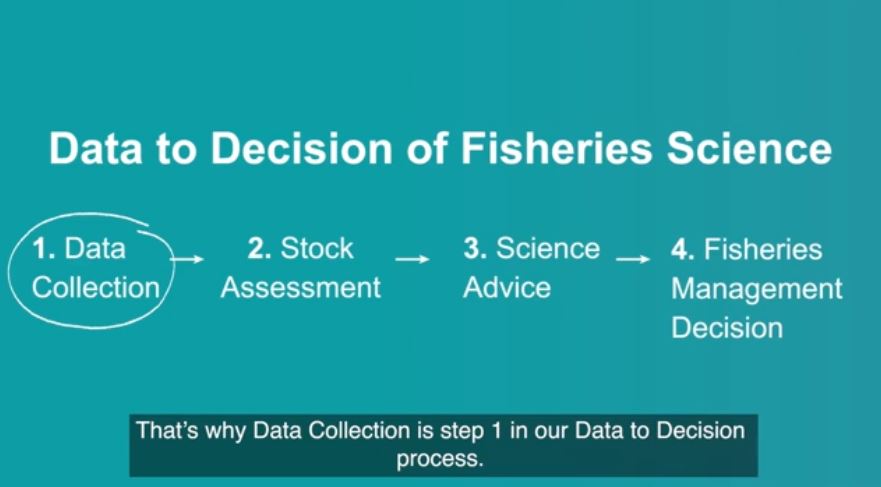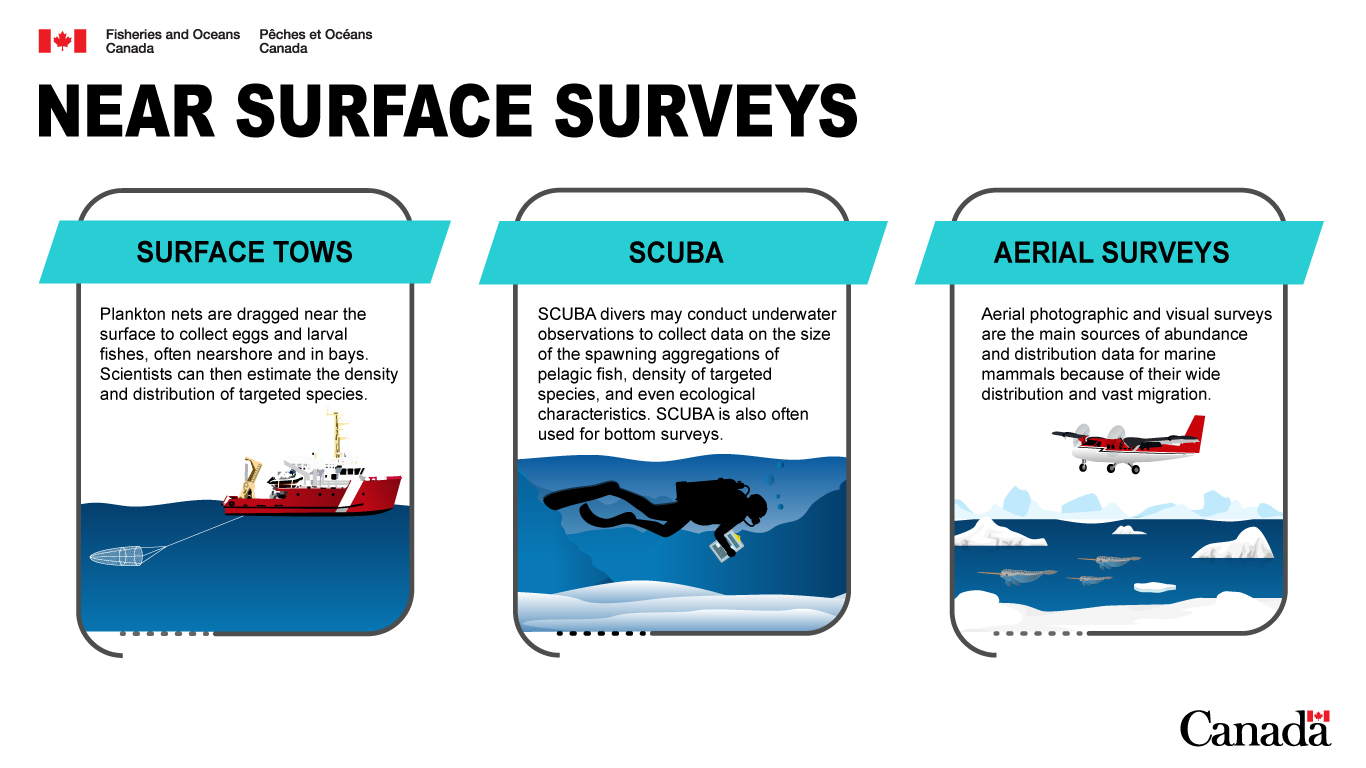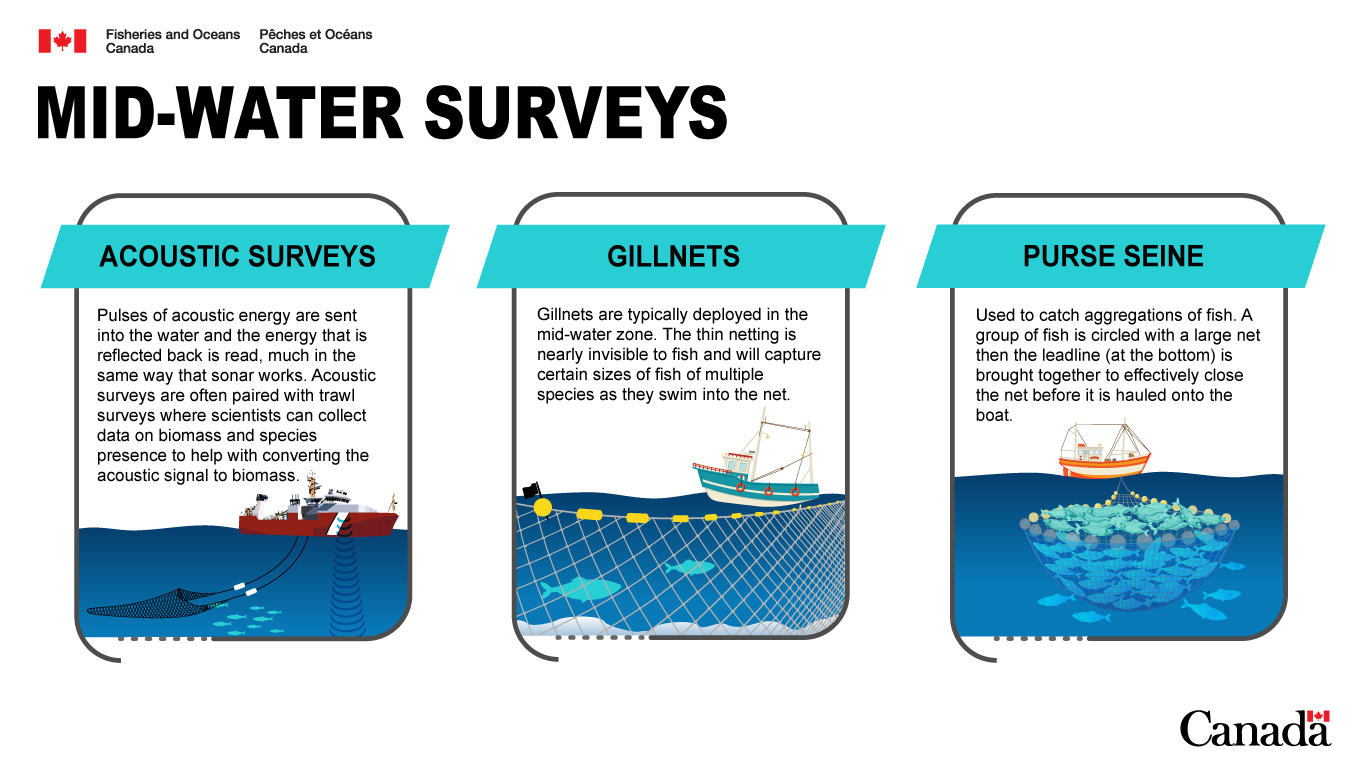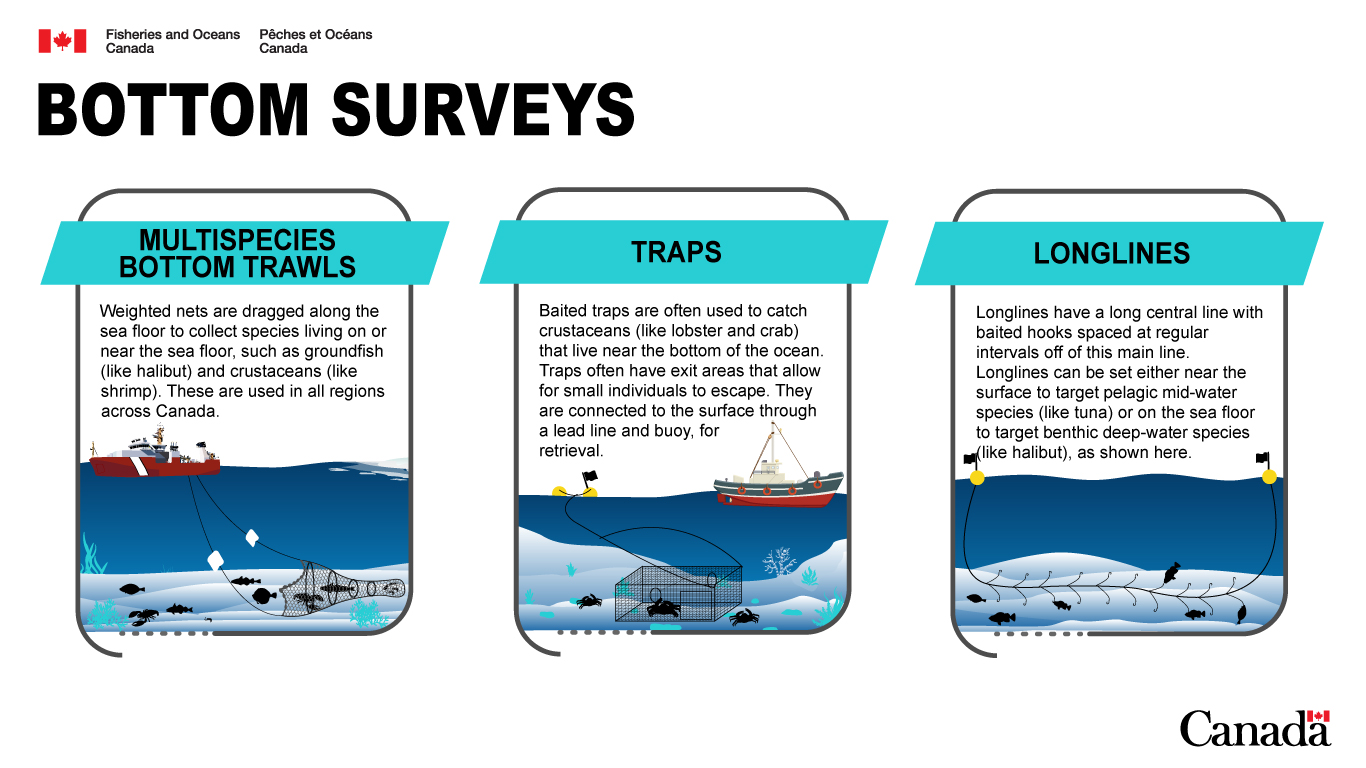Fisheries science: Data collection methods
Data collection is Step 1 in the Data to Decision process.
On this page
Data collection methods
Data collection can be challenging because most fish and other marine species cannot be directly observed in their natural habitat. Some fish move freely over large areas, even leaving Canadian waters, making them difficult to count. Many methods and techniques are used to collect data for stock assessments and other science processes.
Types of assessment data
Types of assessment data
Scientific data used in stock assessments can come from a variety of sources that are grouped into two categories. Data are either collected directly from fisheries (fishery-dependent) or from outside of fisheries (fishery-independent).
Fishery-dependent data
Data that are collected directly from a fishery are called fishery-dependent data and can be collected by government, Indigenous communities, or industry. Data are gathered a variety of ways including:
- self-reporting by fishers
- at-sea observers
- dockside monitoring
- at-sea electronic vessel monitoring systems
A list of different fishery-dependent data gathering methods can be found on the Commercial Fishery Requirements webpage.
These data include information on the catch of each species, including fish that are brought to shore, fish that are released at sea, and fishing effort (the number of nets, boats, and hours spent fishing).
Fish sampled from the catches can provide biological information on the stock, including fish size, age and maturity, and helps us understand how the characteristics of the stock might be changing over time. To gain a deeper understanding of a fish population, we also collect data outside of the fishery using scientific protocols.
Fishery-independent data
Data that are collected from research conducted outside of a fishery are called fishery-independent data. The methods used for this research are often referred to as surveys, where data are collected using set protocols that allow for repeatable and randomized sampling. Data can be collected by government, Indigenous communities, industry or other non-government groups in a number of ways including:
- surveys using trawling, purse seine, gillnet or longline gear
- tagging to monitor movement
- egg and larval surveys
- test fisheries (e.g., to determine timing of spawning or suitability of various gear types)
- visual survey including SCUBA and aerial surveys
- acoustic surveys to find fish using sonar techniques
- biological sampling of fish obtained in surveys
These surveys differ from fishery-dependent methods as they may:
- occur at different times of year than a fishery
- cover different (or smaller or larger) areas than the fishery
- use specialized gear types or sampling methods
Fishery-independent surveys and data can reveal changes in abundance, distribution or biological characteristics of fish populations. The data collected from these surveys can also help us better understand fishery-dependent data. Repeated surveys provide a time series of data that can show how stocks change over time.
Collecting data over a long time series helps us better detect changes in the population. As some fish can live up to 50 years or more, it takes more time for changes to show in the data. Our annual multi-species trawl surveys are longstanding surveys used on all three coasts of Canada. They provide fishery-independent data for key stocks fished commercially and recreationally by covering a wide area and collecting information on the abundance, distribution, and biology of many species.
Survey and gear types
Survey and gear types
Near surface
There are a number of survey methods that happen at or near the surface of the water. These tend to target younger fish at early developmental stages (such as eggs and larvae) or marine mammals.
Mid-water
Mid-water surveys and gear types often target fish that live in the pelagic zone (the area between the surface and the bottom of the ocean), like herring. Depending on the gear type used in a survey, data on multiple species can be collected at the same time.
Bottom
Bottom surveys and gear types target fish that are often associated with the ocean floor, like cod, lobster, crab, geoduck, and rockfish, and other groundfish species. Depending on the gear type used in a survey, data on multiple species can be collected at the same time.
Data collection activities
We’ve been conducting research surveys for decades to generate data to help scientists:
- conduct stock assessments
- provide advice
- track the health of Canada’s fish stocks
Since 2019 we’ve also begun or reinstated a series of at-sea surveys that are designed to expand on our suite of existing surveys and fill gaps in our knowledge of Canada’s fish stocks. Some of these surveys are short-term, address specific questions, and may occur for only one or a few years. Other surveys are designed for long-term monitoring and will be added to our expanding at-sea monitoring surveys list.
Because of the vast size of the oceans and large number of major fish stocks in Canada, we also rely on Indigenous, industry, academic and private partnerships that engage in data collection both nationally and internationally.
Fisheries science research
When providing advice on fish stocks, it helps to have some general information on fish biology and the ecological needs of the stock, such as life history characteristics and predator-prey interactions. We gain a lot of this information from fish samples collected in the fishery and during independent surveys. However, additional research helps to address specific questions that allow us to use the best available information to provide science advice.
We focus our research on improving stock assessment and science advice by:
- increasing knowledge of the biology of fish stocks and factors affecting fish population size, structure, distribution and movements.
- improving the understanding of how management measures may affect stocks
- addressing emerging issues due to changing climate, technology, or fishing behaviour
- reducing uncertainty in fishery-dependent or fishery-independent data by identifying and addressing gaps
- exploring new technologies that may improve or enable more frequent fish stock monitoring
- developing innovative quantitative methods, such as new mathematical models
- collecting additional information about ecosystems and how their various environmental or biological components interact with each other
Related links
- Date modified:



